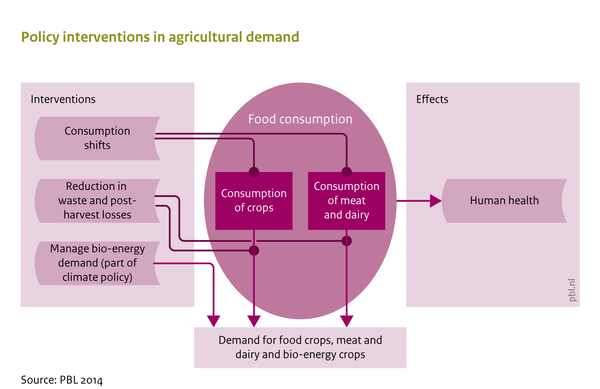Land and biodiversity policies/Agricultural demand
Parts of Land and biodiversity policies/Agricultural demand
| Relevant overviews |
| References |
Interventions targeting agricultural demand
Several policies that affect demand have been analysed using the IMAGE framework , for example, reduction in meat and dairy consumption (Stehfest et al., 2009; PBL, 2011; Stehfest et al., 2013), restricted use of bioenergy, and reductions in losses and waste (PBL, 2010; PBL, 2012).
Shifts in consumption
Interventions that induce shifts in consumption, for example to less meat-intensive diets, directly reduce the demand for animal products (Figure A). As a first order effect, this intervention reduces all upstream effects of production proportionally. Thus, they lead to less demand for animal products and less demand for feed crop production, which in turns requires less land and water and fewer nutrients – if all other settings in the crop production system remain the same – and thus decrease the impacts on biodiversity and climate (Figure B). However, as production systems are heterogeneous between and within regions, the effects may not be proportional. If, for example, extensively farmed agricultural areas, which typically have lower yields than other agricultural lands, are abandoned first, the area reduction will be larger. Likewise, if production shifts to regions with lower yields, less area reduction can be achieved.
In addition to this heterogeneity effect, feedbacks in the economic system via price and trade may change the final impact of a demand intervention, compared to the first-order effect, especially if such interventions are applied in certain regions only. Lower demand for meat may reduce world market prices, and thus increase demand in other regions (Stehfest et al., 2013). Although this rebound effect would reduce the environmental benefits of the intervention, the impact on food security could be positive.
| Policy intervention | Description | Implemented in/affected component |
|---|---|---|
| Changes in consumption and diet preferences | Interventions that target consumption changes or changes in dietary preferences |
(*) Implementing component.
Reducing food losses
Policies aimed at reducing food losses, either via reduced waste at the consumer level, or via reduced post-harvest losses decrease demand for food. This reduces the need to produce food crops, fodder crops and animal products and thus also reduces the environmental impacts of production systems and the area of agricultural land used. However, the same dynamics and second-order effects could be expected as those described under 'shifts in consumption'.
| Policy intervention | Description | Implemented in/affected component |
|---|---|---|
| Reduction of waste/losses | Reduction of losses in the agro-food chain and waste after consumption. |
(*) Implementing component.
Demand for bioenergy
Policy interventions to manage demand for bioenergy directly change demand for bioenergy crops (Figure A). The environmental impacts of such interventions, including land use, depend on the mix of bioenergy crops, and stimulation of and/or restrictions on bioenergy sources. Restricting the use of bioenergy directly affects the options and costs of climate policies (Component Climate policy). The impact of reduced bioenergy demand on biodiversity can be twofold. More bioenergy requires more land and thus involves biodiversity loss (the same dynamics can be expected as under 'shifts in consumption'). However, if policy on bioenergy use is not replaced by other maybe more costly climate policy measures, long-term climate change would be more severe, and thus biodiversity loss due to climate change could also be greater (Oorschot et al., 2010).
| Policy intervention | Description | Implemented in/affected component |
|---|---|---|
| Implementation of biofuel targets | Policies to enhance the use of biofuels, especially in the transport sector. In the Agricultural economy component only 'first generation' crops are taken into account. The policy is implemented as a budget-neutral policy from government perspective, e.g. a subsidy is implemented to achieve a certain share of biofuels in fuel production and an end-user tax is applied to counterfinance the implemented subsidy. | |
| Implementation of sustainability criteria in bio-energy production | Sustainability criteria that could become binding for dedicated bio-energy production, such as the restrictive use of water-scarce or degraded areas. |
(*) Implementing component.

